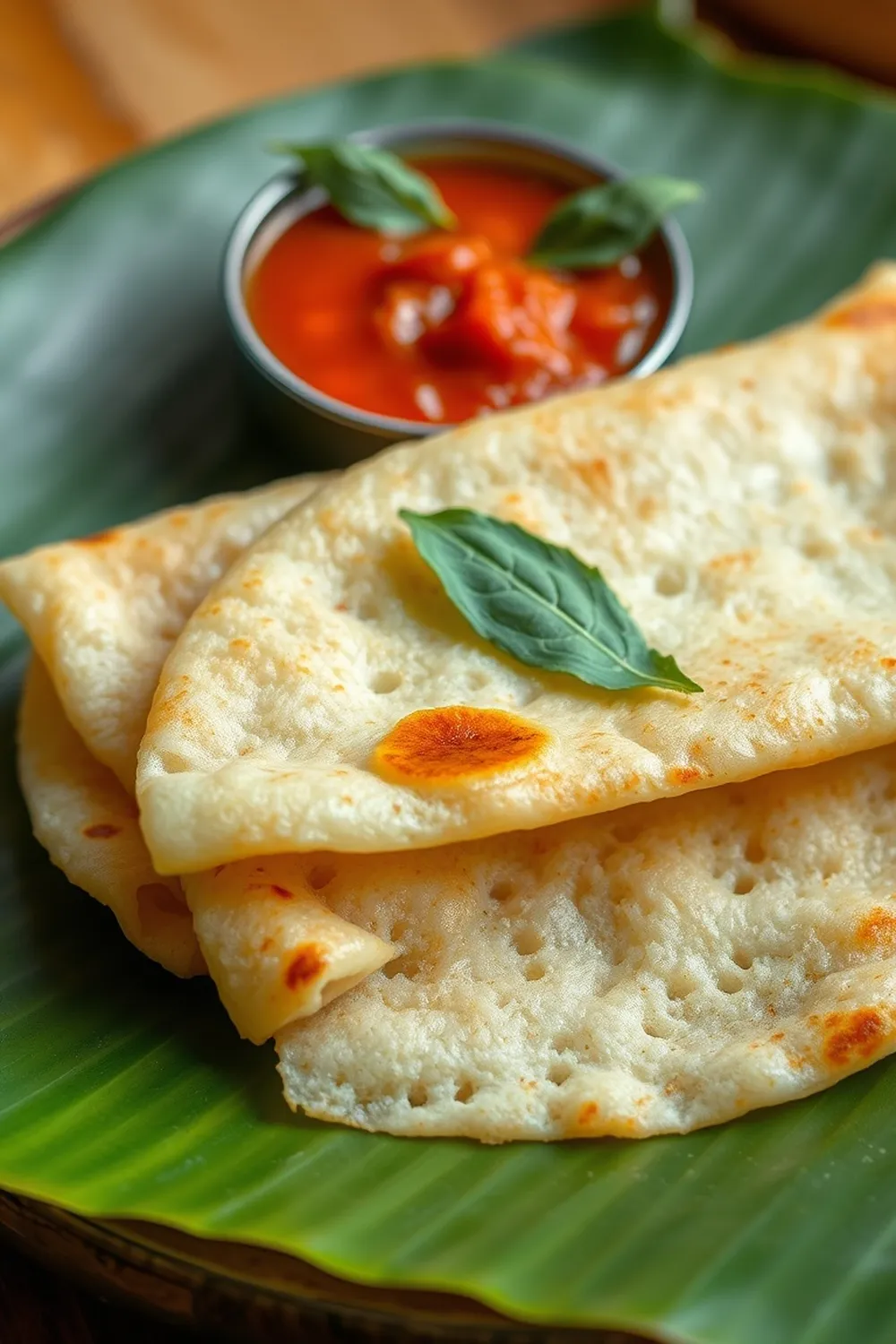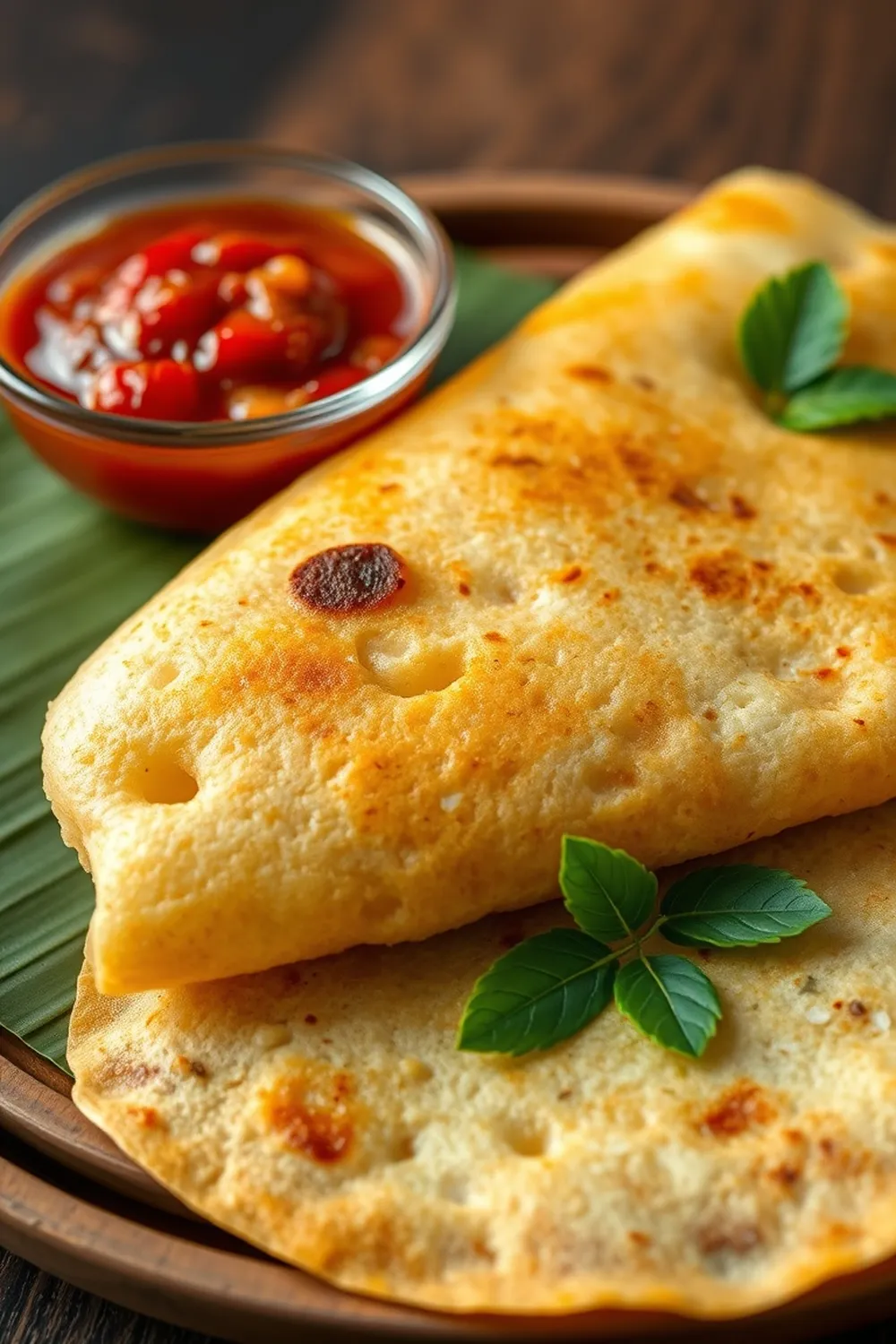- Wash and soak raw rice and urad dal in water for 4-6 hours.
- Drain the soaked rice and urad dal and grind into a smooth paste using a blender with sufficient water.
- Add grated coconut to the batter in the blender and grind again until well combined and smooth.
- Adjust water gradually to achieve a pourable dosa batter consistency. The batter should be smooth and flowing.
- Transfer batter to a bowl, add salt, and mix well. (Fermentation is optional, but improves texture).
- Heat a non-stick tawa or griddle over medium-high heat.
- Pour 2-3 ladles of batter onto the tawa and spread gently into a thin circle, starting from the center.
- Drizzle coconut oil around the edges and cook until the base turns golden brown and crisp.
- Flip the dosa carefully and cook the other side for about 30-60 seconds until lightly golden.
- Serve immediately hot with spicy chutney or sambar.
- Calories:220 kcal25%
- Energy:920 kJ22%
- Protein:6 g28%
- Carbohydrates:30 mg40%
- Sugar:2 mg8%
- Salt:300 g25%
- Fat:8 g20%
Last Updated on 4 months by Neha Deshmukh
Instant Rava Dosa Recipe – Quick & Easy South Indian Breakfast
Hey everyone! If you’re anything like me, mornings can be… hectic. Between getting ready for the day and making sure everyone’s fed, sometimes a long, drawn-out breakfast just isn’t in the cards. That’s where this Instant Rava Dosa recipe comes in – it’s a total lifesaver! Seriously, this is my go-to when I want a delicious, authentic South Indian breakfast without spending hours in the kitchen.
Why You’ll Love This Recipe
This isn’t your grandma’s dosa (though hers are amazing, right?). This recipe skips the fermentation process, making it perfect for busy mornings or when you’re craving dosa right now. It’s quick, easy, and delivers that satisfying crispy-yet-soft texture we all love. Plus, it’s naturally gluten-free! Honestly, once you try this, you’ll wonder why you didn’t make instant dosas sooner.
Ingredients
Here’s what you’ll need to whip up a batch of these beauties:
- 1 cup raw rice
- 2 tbsp urad dal (split black lentils)
- ?? cup grated coconut (fresh is best!)
- Salt as needed
- Coconut oil for cooking
Ingredient Notes
Let’s talk ingredients for a sec. Using good quality raw rice and urad dal is key to getting the right texture. I usually use sona masuri rice – it works beautifully.
Now, about that coconut! Freshly grated coconut makes all the difference. It adds a lovely sweetness and aroma. If you can’t find fresh, unsweetened desiccated coconut is okay, but try to avoid pre-shredded, sweetened coconut.
Coconut usage varies across South India. In some regions, they use a lot, while others prefer a more subtle coconut flavor. Feel free to adjust the amount to your liking – I usually add about ¾ cup, but sometimes I go a little overboard!
Step-By-Step Instructions
Alright, let’s get cooking!
- First, give the raw rice and urad dal a good wash. Then, soak them in water for 3-4 hours. This softens them up for a super smooth batter.
- Drain the soaked rice and dal. Pop them into a blender and grind until you have a really smooth paste. You might need to add a little water to get things moving, but go slowly – we want a thick paste, not soup!
- Now, add the grated coconut to the blender and grind again until everything is combined and smooth.
- Add water gradually to the batter, mixing as you go, until you reach a pourable dosa batter consistency. It should be similar to pancake batter.
- Transfer the batter to a bowl, add salt to taste, and give it a good mix. No fermentation needed – that’s the beauty of this recipe!
- Heat a non-stick tawa (griddle) or frying pan over medium heat. A well-seasoned cast iron tawa also works wonderfully.
- Pour about 1.5 ladles of batter onto the hot tawa and gently spread it into a thin circle. Don’t worry if it’s not perfect – practice makes perfect!
- Drizzle some coconut oil around the edges of the dosa. This helps it get nice and crispy. Cook until the base turns golden brown.
- Flip the dosa carefully and cook the other side briefly. It doesn’t need long – just a minute or so.
- Serve immediately with your favorite chutney or sambar!
Expert Tips
- Tawa Temperature: Getting the tawa temperature right is crucial. If it’s too hot, the dosa will burn. Too cold, and it’ll stick. Medium heat is your friend!
- Batter Consistency: The batter should flow easily but not be too runny. If it’s too thick, add a little water. Too thin? Add a tablespoon of rice flour.
- Non-Stick is Key: While you can use a traditional tawa, a good non-stick pan makes life so much easier, especially when you’re starting out.
Variations
Want to switch things up? Here are a few ideas:
- Gluten-Free Adaptation: This recipe is already gluten-free, but double-check your coconut oil to ensure it’s processed in a gluten-free facility if you have severe allergies.
- Spice Level Adjustment: My friend Priya loves a little kick, so she adds a pinch of chili flakes to the batter. Feel free to experiment!
- Quick Breakfast Variation: Add a finely chopped onion and some chopped coriander leaves to the batter for an extra flavorful breakfast.
- Regional Coconut Variations: My aunt in Kerala always adds a teaspoon of sugar to her dosa batter, along with the coconut, for a slightly sweeter dosa. It’s delicious!
Serving Suggestions
Dosa is best enjoyed hot off the tawa! I love serving it with:
- Spicy Coconut Chutney
- Sambar (lentil-based vegetable stew)
- A dollop of ghee (clarified butter)
- A side of potato masala (aloo masala)
Storage Instructions
While this dosa is best enjoyed fresh, you can store leftover batter in the refrigerator for up to 2 days. It might thicken slightly, so add a little water before using.
FAQs
Let’s answer some common questions:
- Is fermentation required for this dosa batter? Nope! That’s the whole point of this instant recipe. We skip the fermentation process for a quick and easy breakfast.
- What type of rice is best for making this dosa? Sona masuri rice works great, but you can also use parboiled rice or idli rice.
- Can I use store-bought coconut milk instead of grated coconut? You can, but the flavor won’t be quite as authentic. If you do, use about ½ cup of coconut milk.
- How do I prevent the dosa from sticking to the tawa? Make sure your tawa is hot enough and well-oiled. A good non-stick pan also helps!
- What is the ideal consistency of the dosa batter? It should be pourable, like pancake batter. Not too thick, not too thin.
Enjoy! Let me know in the comments if you try this recipe and how it turns out. I love hearing from you all!








